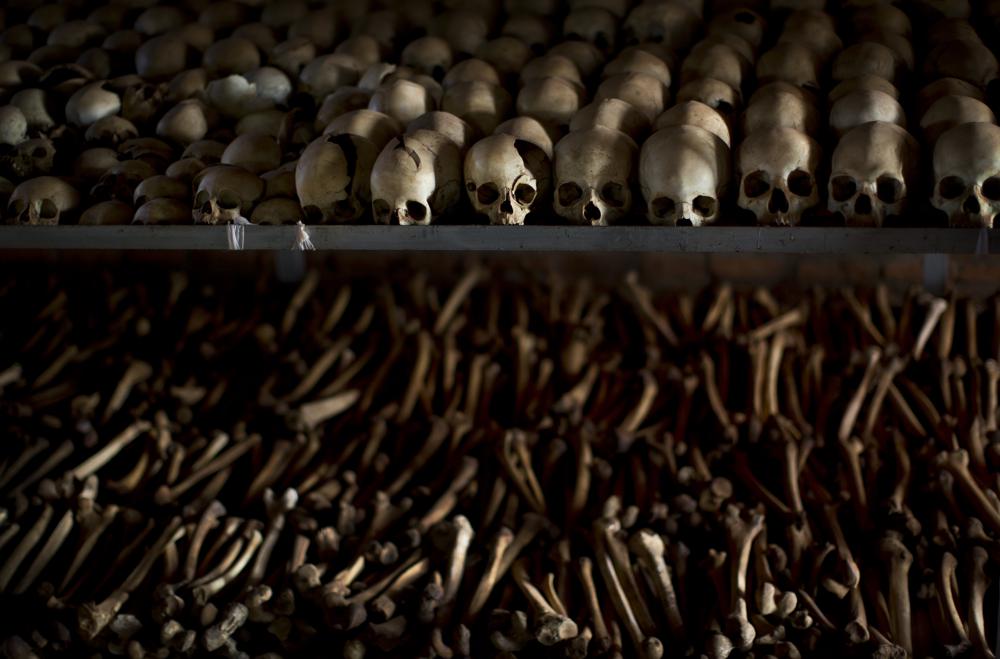
Dark Tourism Attracts Tourists to Rwanda
Dark tourism refers to visiting places where some of the darkest events of human history have unfolded. That can include genocide, assassination, incarceration, ethnic cleansing, war or disaster either natural or accidental. Some might associate the idea with ghost stories and scares, but those who study the practice say it’s unrelated to fear or supernatural elements. To many visitors who plan safaris in Rwanda, genocide memorial sites are among the attractions that do not miss in tour itineraries;
RWANDA GENOCIDE BEGINS
On April 6, 1994, a plane carrying Habyarimana and Burundi’s president Cyprien Ntaryamira was shot down over the capital city of Kigali, leaving no survivors. (It has never been conclusively determined who the culprits were. Some have blamed Hutu extremists, while others blamed leaders of the RPF.)
Within an hour of the plane crash, the Presidential Guard, together with members of the Rwandan armed forces (FAR) and Hutu militia groups known as the Interahamwe (“Those Who Attack Together”) and Impuzamugambi (“Those Who Have the Same Goal”), set up roadblocks and barricades and began slaughtering Tutsis and moderate Hutus with impunity.
Among the first victims of the genocide were the moderate Hutu Prime Minister Agathe Uwilingiyimana and 10 Belgian peacekeepers, killed on April 7. This violence created a political vacuum, into which an interim government of extremist Hutu Power leaders from the military high command stepped on April 9. The killing of the Belgium peacekeepers, meanwhile, provoked the withdrawal of Belgium troops. And the U.N. directed that peacekeepers only defend themselves thereafter.
SLAUGHTER SPREADS ACROSS RWANDA
The mass killings in Kigali quickly spread from that city to the rest of Rwanda. In the first two weeks, local administrators in central and southern Rwanda, where most Tutsi lived, resisted the genocide. After April 18, national officials removed the resisters and killed several of them. Other opponents then fell silent or actively led the killing. Officials rewarded killers with food, drink, drugs and money. Government-sponsored radio stations started calling on ordinary Rwandan civilians to murder their neighbors. Within three months, some 800,000 people had been slaughteredMeanwhile, the RPF resumed fighting, and civil war raged alongside the genocide. By early July, RPF forces had gained control over most of country, including Kigali.
In response, more than 2 million people, nearly all Hutus, fled Rwanda, crowding into refugee camps in the Congo (then called Zaire) and other neighboring countries.
After its victory, the RPF established a coalition government similar to that agreed upon at Arusha, with Pasteur Bizimungu, a Hutu, as president and Paul Kagame, a Tutsi, as vice president and defense minister.
Habyarimana’s NRMD party, which had played a key role in organizing the genocide, was outlawed, and a new constitution adopted in 2003 eliminated reference to ethnicity. The new constitution was followed by Kagame’s election to a 10-year term as Rwanda’s president and the country’s first-ever legislative elections.
RWANDAN ETHNIC TENSIONS
By the early 1990s, Rwanda, a small country with an overwhelmingly agricultural economy, had one of the highest population densities in Africa. About 85 percent of its population was Hutu; the rest were Tutsi, along with a small number of Twa, a Pygmy group who were the original inhabitants of Rwanda.
Part of German East Africa from 1897 to 1918, Rwanda became a Belgium trusteeship under a League of Nations mandate after World War I, along with neighboring Burundi.
Rwanda’s colonial period, during which the ruling Belgians favored the minority Tutsis over the Hutus, exacerbated the tendency of the few to oppress the many, creating a legacy of tension that exploded into violence even before Rwanda gained its independence.
A Hutu revolution in 1959 forced as many as 330,000 Tutsis to flee the country, making them an even smaller minority. By early 1961, victorious Hutus had forced Rwanda’s Tutsi monarch into exile and declared the country a republic. After a United Nations referendum that same year, Belgium officially granted independence to Rwanda in July 1962.
Ethnically motivated violence continued in the years following independence. In 1973, a military group installed Major General Juvenal Habyarimana, a moderate Hutu, in power.
The sole leader of Rwandan government for the next two decades, Habyarimana founded a new political party, the National Revolutionary Movement for Development (NRMD). He was elected president under a new constitution ratified in 1978 and reelected in 1983 and 1988, when he was the sole candidate.
In 1990, forces of the Rwandese Patriotic Front (RPF), consisting mostly of Tutsi refugees, invaded Rwanda from Uganda. Habyarimana accused Tutsi residents of being RPF accomplices and arrested hundreds of them. Between 1990 and 1993, government officials directed massacres of the Tutsi, killing hundreds. A ceasefire in these hostilities led to negotiations between the government and the RPF in 1992.
GENOCIDE MEMORIAL SITES
Some of the major memorials centers are highlighted below; you can request to visit any of them depending on their location and your itinerary.
Kigali Genocide Memorial Center
The Kigali genocide memorial center is located 10 minutes’ drive from the city center in Gisozi. It is the final resting place of 250,000 Rwandans killed in the genocide. It is run by AEGIS, a UK Non-Governmental Organisation committed to stop genocides from happening around the world. The center has different exhibit places with space of skulls of survivors and their personal belongings, photographs of survivors, reconciliation efforts, and genocide perpetrators. Another space has photographs and descriptions of genocides that have happened around the world showing that this indeed is not a Rwandan problem but a world problem that should never happen again. Outside the building, there is a garden and different mass graves where survivors and those who lost loved ones can come to‘re-connect’. This can be included on your itinerary while on the Kigali city tour because of its location near the city center.
Murambi Genocide Memorial
Murambi genocide memorial set on the grounds of former Murambi technical school near Murambi town is by far the most difficult memorial to visit because of the bodies and skeletons of genocide victims on display. One can almost recognize and identify a survivor if indeed they were a relative or friend. Tutsi were advised to hide in the technical school with pretext that French soldiers would protect them but alas, it was a trap. After gathering there, they had no food and were attacked by the militia. The site has several mass graves with former classrooms acting as exhibition rooms.
Nyamata Genocide Memorial
Nyamata genocide memorial center is a former church located 30 km south of Kigali in Bugesera. The center commemorates the 25,000 Rwanda genocide victims buried here. This is one of the more dark sites in Rwanda after Murambi genocide memorial.
It is unfortunate that many Tutsi people gathered here considering it a safe sanctuary because previously churches were seen as safe places. Little did they know that this building was a pure death trap as opposed to life? The Tutsi’s had locked themselves up in the church seeking safety but were shocked when Hutu militias forced open the doors open with hand grenades and reigned on them with machetes. You will find clothes and national ID cards of the dead victims on the church pews with blood spread all over the place. The alter cloth is still stained with blood from the massacre of the several victims. Outside the church are mass graves for your visits.
Nyanza Genocide Memorial
Nyanza genocide memorial located on the grounds of Kigali’s Ecole Technique Officielle in Kicukiro district – Kigali city . This often acts as the grounds for the genocide anniversary commemorations which happen yearly in April. It holds the graves of more than 10,000 genocide victims abandoned by the Belgian UN peacekeeping forces as the genocide intensified. The UN forces left these Tutsi’s in the hands of their massacres by not airlifting them to the safety they themselves were going, a sad story of bureaucracy.
Bisesero genocide memorial
Its located 60 km from Kibuye, Rwanda with 40,000 people said to have died here. This genocide memorial site is a story of resistance of the Tutsi’s against their attackers the Hutu’s in the hills of Bisesero where they used stones and sticks to counter the Hutu attack.
Ntarama genocide memorial
It is an hour’s drive from Kigali. It is a former catholic church where 5000 people were massacred. It is much smaller than the other church genocide memorial sites because it was a small village parish. Just like the others, the Tutsi’s came here for refuge assuming that it would be safe but were shocked by attacks from the Hutu militias, who in some place accessed the building by removing bricks one by one.
Nyarubuye genocide memorial
Site located 140 km from Kigali is Catholic Church where 2000 Rwandan were killed. It is said that Sylvestre Gacumbitsi the then mayor of the district was involved in distributing arms and encouraging Hutu’s to use rape and later maim and kill the Tutsi’s. Unlike Ntarama and Nyamata genocide memorial sites, Nyarubuye was restored into a church and is currently used by people in the area with the memorial center adjacent to the church.
Conclusion
Although the Rwanda genocide tour is considered as dark tourism, it has brought peace and joy in the hearts of natives and the tourists that visit the different sites because even after killings of different groups of people the genocide came to an end there has been harmonious living among different groups of people. Regardless of the tribe differences, acts of racism are now prohibited and today Rwandans refer themselves as one people.
Read MoreEmmanuel Tutu: Football Star, Visual Artist and Philanthropist
For Emmanuel Tutu, using art as a medium to benefit the wider society is a divine calling. As Joseph Ondiek writes, Tutu is using a percentage of his art sales proceeds to help Rwandan children to get education and to also buy health insurance poor women.
“I believe that everybody should use his or her talent, a God-given gift, to right what’s wrong in society. I identified the education of children, particularly girl-child education, as my priority area and now I have many of them I have put through education,” Tutu told Chwezi Traveller in an interview in Kacyiru, a Kigali suburb.
Tutu says it’s the travails of his parents that set him on the path of philanthropy. His parents escaped to the Democratic Republic of Congo (DRC) in 1959 during the volatile period of that time. There were sporadic ethnic conflicts pitting the two dominant communities in Rwanda that later culminated in the atrocious 1994 genocide against the Tutsi.
A top-flight footballer
Born in Uganda, Tutu’s early passion was football where he played in Uganda’s top division. But despite that, he always wanted to come back to his motherland after peace was restored. His mother came back to Rwanda 1997.
Tutu’s father died in 1990 and a widowed mother raised the family. His family was composed of seven siblings, five boys and two girls. The mother went back to Uganda but came back in 2005 with some of her children.
As a self-made painter, Tutu says when he came back to Rwanda in 2006, at first he didn’t know what he was going to do for a living. He came back with the family to play football, but after suffering an injury, “we went back to Uganda.”
When he finally relocated to Rwanda in 2006, he managed a music production studio owned by his young brother. The company also was running Narrow Ministry, an orphanage based in Kigali.
Later, he met Innocent Nkurunziza who at the time was a budding painter at Rwanda’s pioneer contemporary art center called Ivuka Art Center in Kacyiru, Kigali, established by renown Ugandan painter, Collin Sekajugo.
Nkurunziza and his brother Emmanuel Nkuranga established Inema Art Center in 2012 where he joined them to become one of the resident artists.
And things have looked up for him since then.
“I have done group exhibitions at the US Embassy in Kigali, the United Nations in Kigali, the Rwanda Museum, Jumelage Rhineland in Kigali and different hotels and restaurants in Rwanda. In 2016, I did an exhibition at Biennale de Dakar Xll in Senegal. I have also been sending my artwork to the United States, Scotland and Speyer in Germany,” Tutu says.
He says that in the recent years, his work has received a lot of recognition. “My deep passion for art, which I started when I was a young boy, has also made me to do philanthropic work such as helping disadvantaged children with school fees to go to school, and buying the coveted health insurance, Mutuelle de Sante, for vulnerable women,” Tutu adds.
A heart for the disadvantaged
He says that he has a big heart for humanitarian projects, adding that he puts aside 20 per cent of the money he gets from selling his art pieces to support schoolchildren and women.
“Part of my sold paintings have contributed to far-flung projects in Home for Love in Haiti, Narrow Ministry Rwanda and my own initiative called Tutu Foundation Ministry, which helps disadvantage families,” he says.
Tutu says while his passion is painting African stories, he draws most of his inspiration from the everyday struggles of women. In fact, most of Tutu’s paintings depict the normal struggles and positive images of how an African woman not only gives life but also nurtures it.
The titles of his work include a 70×40 acrylic on canvas called Proud Woman, depicting an African woman carrying a child on her back. There is also a 100×75 untitled piece showing three women carrying big baskets on their heads, going to the marketplace to sell their produce.
Tutu does abstract, semi-realism art where his pieces also depict
conservation efforts. He says that the image of the African woman is not just giving life. She nurtures life, Tutu argues, and many images of the woman carrying a child on her back, even as she carries on with her domestic duties, have been documented by the artist.
“My work focuses on women to empower them and promote positive things they do to help uplift the institution of the family. I believe that without women, the society is dead,” he says.
Tutu adds that he believes that visual art has a greater role to play in the social, economic and political development of any society. It helps to serve various purposes and, as a form of expressionist art, it has been used as a means of educating and empowering society.
Read More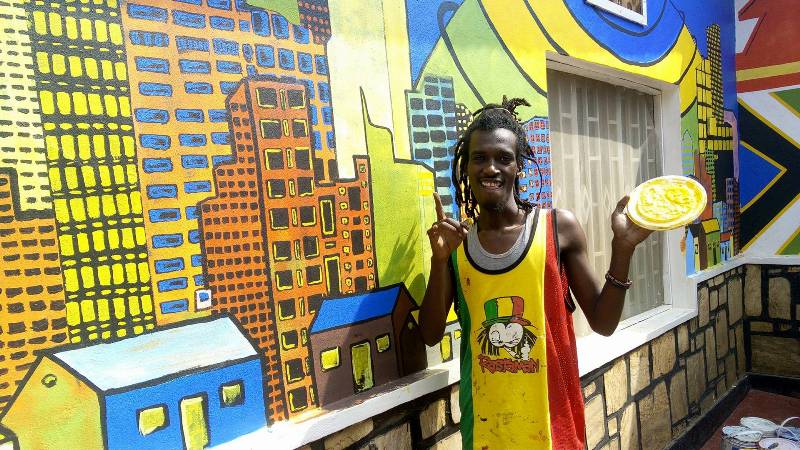
Ntagara’s Passion for Nature gives Birth to Kigali’s Newest Art Centre
The question most people often ask: what’s the connection between art and environmental conservation?
For Djamal Ntagara, the answer is quite crystal clear: there are numerous ways to conserve our nature, but art is among key methods which help people feel the significance of helping protect the planet.
Through the power of true pieces of art, he says, the viewer’s eyes open and appreciate beauty and, through this, the wonderful uniqueness and preciousness of our fauna and flora.
He adds that art not only provides the visual beauty but also a therapeutic sense of serenity; connecting emotions through interpretation of what you see in any particular piece of art.
The love for conserving the environment and culture is the inspiration behind the founding of another art center by Ntagara, known as Kaanyaburanga Art Center. This new addition to Kigali’s ever burgeoning art scene is located in Sonatube, right behind the Classic Hotel in Kicukiro.
Ntagara, 27, says the new art center is going to be officially opened late in march with initial three members. The others are Mike Katihabwa, a Burundian artist who escaped from the conflict-ridden country in 2015 during the elections-related violence and is now living in Kigali. The other one is Neza Shemsa, a youthful female artist known for her “touristic” paintings depicting wildlife and culture.
When you set your foot right into the new art center, what Ntagara says about his love for nature immediately confronts your eyes. At the verandah of this former residential place he has now been transformed into an art center, you find different types of flowers planted on discarded objects that he says he “raised from the dead and breathed life into them.”
For instance, we know that a junk computer belongs to the scrapyard. However, Ntagara is now growing blooming pieces of flowers from an improvised flower “pot” on a junk computer monitor he says he retrieved from his father’s house.
“The computers were dead, and my father wanted me to throw them away. But instead, I removed their insides, filled up soil in the shell of the monitors, and painted them in attractive colours from where I planted the flowers,” he says.
He used other parts of the computers like the motherboard to make installation art that hangs attractively on the walls of the gallery.
The other pieces of discarded materials he used as flower pots include used jerrycans and other used objects.
An installation art depicting a fish is made from discarded toothbrushes, toothpaste tubes that he says he collected from his father’s garden when he wanted landscape the garden with flowers. The pieces are embedded on a 170 x 40cm wooden piece. He uses saw dusts to make some features of the fish like the head and tails, but gives it a bluish and attractive background.
Another exquisite of installation art is found on the walls of the main gallery where he collected different coins from different countries, several discarded keys and seashells and glued them on a square piece of wood to make a wall clock.
“This piece of art is priceless and I can’t sell it for a farthing or a fortune. Instead, I’ll one day donate it to a museum because it represents some part of our history from the materials used,” says the artist.
Apart from the main gallery located in the former sitting room of the residential building, another room is going to be a place they are going to display masks, banana lampshades, bracelets and jewellery made from the center and others brought in by other artists for display and sales.
For his love of culture, Ntagaara explains that he plans to hold monthly cultural events at Kaanyaburanga that will bring the old and the young together to share their different perspectives and experiences.
“Our culture is dying because the youth today miss the opportunity to learn from the old. However, we need to come together and share our history to preserve our pristine culture. We are going to create that opportunity here at the center,” he adds.
Ntagara says he’s happy to collaborate with artists who share his passion for the love of nature and culture like Katihabwa and Neza. “The creation of the art center has provided me with the opportunity to express what’s within me and to fulfill my dreams of being a conservation artist. I am working with these youthful artists who share my passion to fulfill this dream,” he says.
Ntagara formerly worked at the now defunct Uburanga Art Center in Kimihurura before founding the new art center.
Read More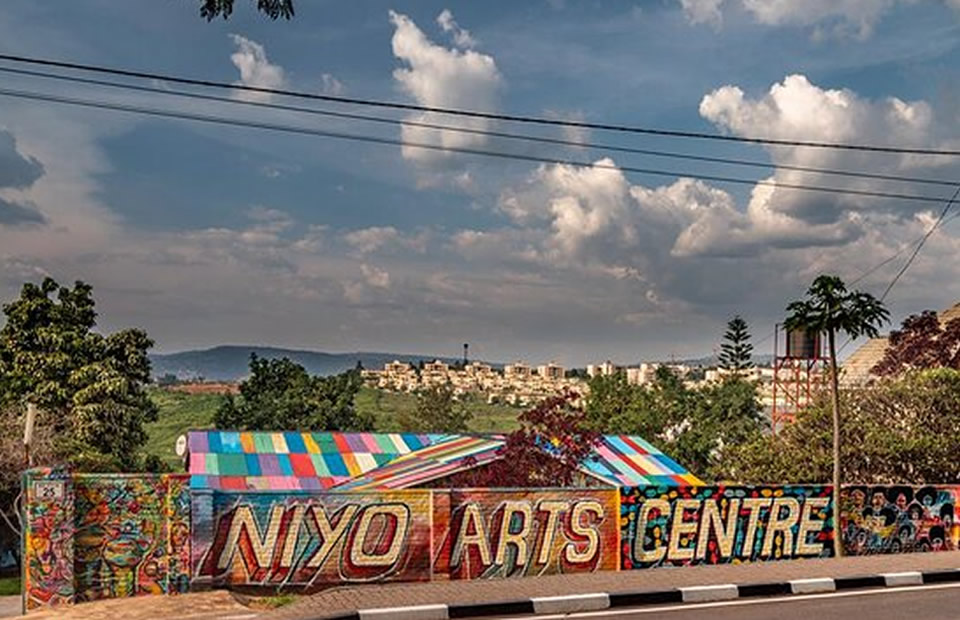
Niyo Art Centre Gives Hope to Children with Horrible Past
It’s five O’clock in the evening. The first sounds of drums penetrate the quiet Kacyiru neighborhood, Kigali, where Niyo Art Centre is located.
Inside, a group of adults are standing behind five waist-high drums they beat furiously but happily, as some dozen children or so respond to the sounds of the African drumbeats with scintillating dance. There is also a group of singers that belt out songs to accompany the drums.
After about nine minutes, the sounds of the drums slowly fade, and the dancing children wipe their brows of sweat and their feet of dust, as they prepare for another performance. A group of five tourists huddled together in front of performance clap their hands in unison.
However, despite the glow in their faces after being lost in the frenzy of their performance, what is indiscernible is that these children have a past. A horrible past.
Some of them have hitherto spent their lives on the streets, and slept on empty stomachs. They have only known pain, hunger and suffering throughout their brief existence in the world.
Some of them come from indigent backgrounds, their parents too poor to afford their meals, not forgetting education. Some of them are orphans who have never experienced parental love.
But now, their faces are beaming with hope for the future, thanks to Niyo Arts Gallery. Founded by Pacifique Niyonsenga in 2015, the art gallery has become a cradle of hope for these children who now go to school and also have a roof over their heads, as opposed to their former life where the world was too full of void and hopelessness.
Niyonsenga, himself a former street boy until a benevolent hand, a Canadian named Bruno Soucy, became his close friend, plucked him off the streets and helped him get education, says the art gallery was established to help them use their talents in arts to assist these vulnerable children.
He had established a charity organisation in 2012 to help street children get education as a tribute to his Canadian benefactor.
Niyonsenga, a prodigious visual artist and a drummer, says the charity organisation started with only 28 children in 2012 but now has 120.
“We have made tremendous development since its inception. We have managed to take the children to different schools, buy them scholastic materials and rent them houses in Gasabo district, Kigali,” Niyonsenga said in an interview with Chwezi Traveller.
He says that Niyo Art Gallery has now established a reputation as a top tourist attraction in Gasabo district, Kigali, on its own merit because of the programmes they have initiated and attractive arts and handicrafts that can be found inside the gallery.
Niyo Arts Gallery now has 11 artists displaying their artwork there. He says he and the other artist at his gallery donate 40% of their artwork sales to educate and house the children. They have also managed to attract a group of donors that support their programmes.
“We have managed to take one of our children up to the university, 23 are in secondary school while 68 are in primary. It’s gratifying that when art lovers purchase our products, the proceeds go for good purpose,” says Niyonsenga.
Apart from operations in the gallery, he adds that they also do exhibitions and sales abroad where they raise up money to plough back to help the children.
He says that in 2017 the centre held 10 different exhibitions: two in the USA, one in Belgium, one in Netherlands and Six in Kigali. “We have also acted as ambassadors of our culture in different capitals around the world when we showcase Rwanda’s arts and crafts abroad.
Most people in the Western world know Rwanda because of the insidious genocide, and they get mesmerized when we go out there and show them the real Rwanda,” says Niyonsenga.
Read More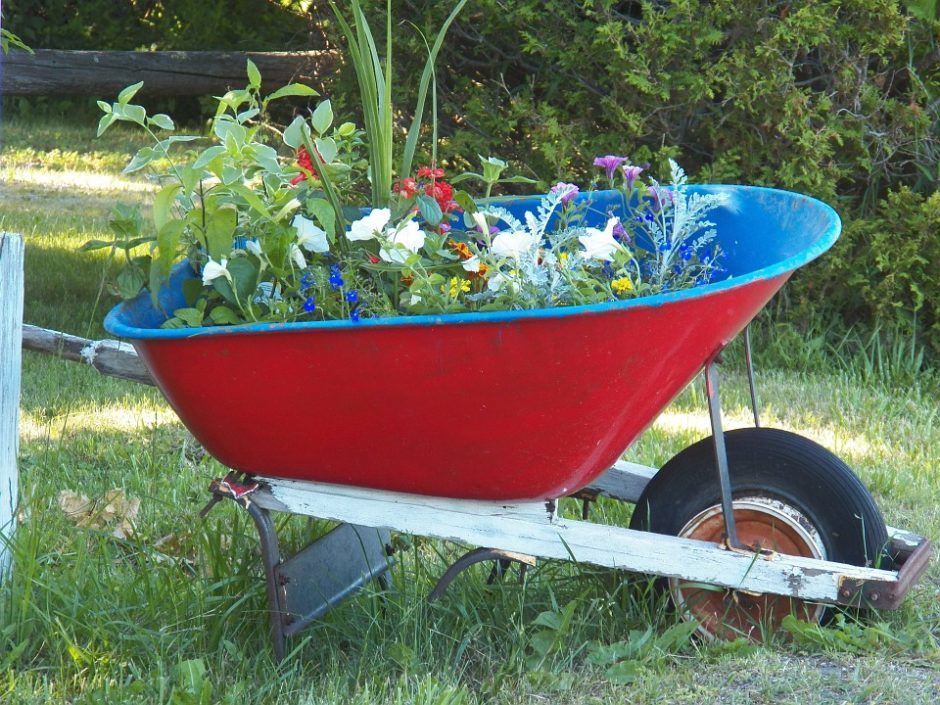
Audry’s Garden
par Nadia Nehari
Audry-Kévin Jimbere est un jeune Burundais qui crée son propre emploi en créant sa société de service ‘Audry’s Garden’ consacrée au jardinage….
TEM : Quel âge as-tu Audry-Kévin et quel est ton cursus?
Audry : Je viens de terminer mes études dans la faculté de Gestion et Administration (Business and Administration).
TEM : Comment t’es venu l’idée de créer une société de Service à Bujumbura tel que Audry’s Garden?
Audry : L’idée m’est venue quand j’ai vu que certaines résidences et habitations avaient de grand jardins et qu’ils étaient difficiles à entretenir et à embellir. C’est là où je me suis m’y à réfléchir comment apporter une solution pratique pour l’entretien de jardin. J’ai constitué une équipe avec mon propre jardinier et vu les résultats positifs et la demande croissante et l’encouragement des clients, j’ai crée la société de service ‘Audry’s Garden’ qui est composée de plusieurs personnes (femmes et hommes) à qui j’ai donné un emploi. Une maison et un jardin bien entretenu est l’image de la personne qui y habite, pour moi il est très important de vivre dans un bel environnement et entouré de la nature dans sa maison… Le Jardin!
TEM : Quel est le conseil que tu donnerais aux jeunes burundais de ton âge dans leur recherches d’emploi?
Il y a beaucoup de choses à faire au Burundi. Je pense que vu le taux de chômage élevé dans notre pays. Les jeunes comme moi devons nous mettre en tête de créer notre propre emploi! Il faut juste aimer le travail et s’y consacrer à fond et y donner tout son cœur! C’est cela notre avenir!
J’espère qu’avec le projet que j’ai mis en place je servirai un modèle pour les autres jeunes car j’ai eu le courage de me lancer et j’’ai réussi à créer mon propre emploi.
TEM : Quel est ton/tes passes temps favori(s) à part le travail et comment l’utilises-tu?
Je suis une personne très sociale, j’aime passer du temps avec mes amis. J’aime aussi le business- cette passion, je la porte dans mon cœur…
Contact: jimberea@yahoo.fr Tél: +257 78808359
Read More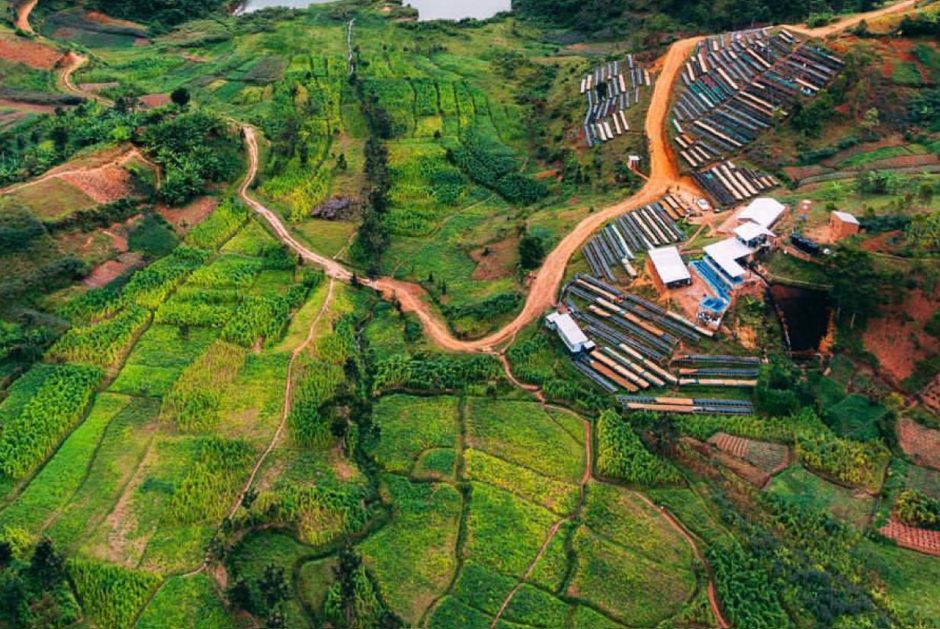
Must Sees’ In Gitega Rwanda
GITEGA NATIONAL MUSEUM
The Gitega National Museum, located at the entry into Gitega city is one of the best places you could go to for archival information about the history of the country. Like the old woman of the clan who knows all the old stories but neglects her appearance, the general aesthetics of the structure leave a lot to be desired, but once you engage with her, the information you gain is well worth the effort.
On display are photographs explaining Burundi’s rich cultural past, ancient monarchies, and architecture. There is also information about the country’s more recent turbulent history, including tragic tales of ethnic conflict and genocide.
GISHORA DRUM SANCTUARY
A Gishora is one of Burundi’s most famous drum sites. It is about 5km from Gitega town and 200m off the Gitega-Ngozi route. It was founded by King Mwezi Gisabo and placed under the care of a local community called ‘Abatimbo’, descendants of the ancient lineage of ‘Abanyigisaka’. The site of Gishora also houses two ritual drums that were never beaten: Ruciteme and Murimirwa. A guide stationed at the site will share their fascinating story. The site also recreates an architectural complex of a Royal palace, rarely found elsewhere in the country.
KARERA FALLS
A visit to these fascinating falls is generally considered a rite of passage for all visitors to Burundi. Karera waterfalls are situated about 45 km East of Gitega town, within an intimate enclave of towering trees. You can take different routes around the falls to see the six branches of the falls in all their glory. In total, the falls are spreads over three levels of dramatic beauty.
The area around Karera falls is also a great place to do some birding as there are a number of rare birds in the area.
THE GERMANS’ FAULT (RIFT)
The Germans’ Rift is also known as the Nyakazu Rift. This site is located 50km due East of Gitega on Nkoma Mountain in Kayove District. The legend goes that the first King of Burundi appeared on this mountain in the 15th century, before progressing to the heights of Muramvya. Nyakazu was a German military Station (BOMA) built for controlling the eastern part of the country up to Tanzania in 1914, the beginning of the First World War. A few stones from this historic building remain visible from the south of the Rift. The name “Germans’ Rift” is inspired by a tale that the plateau of Nkoma on which BOMA was built, “was split by the boots of German soldiers fleeing the Belgian forces”.
Other places you may want to visit include: Gishuha hot water springs (about 10 km north of Gitega city center) and (for Catholics especially) Mugera pilgrimage site (20 km from the center of Gitega) where the first missionaries are said to have arrived in Gitega in the late 19th century.
Read More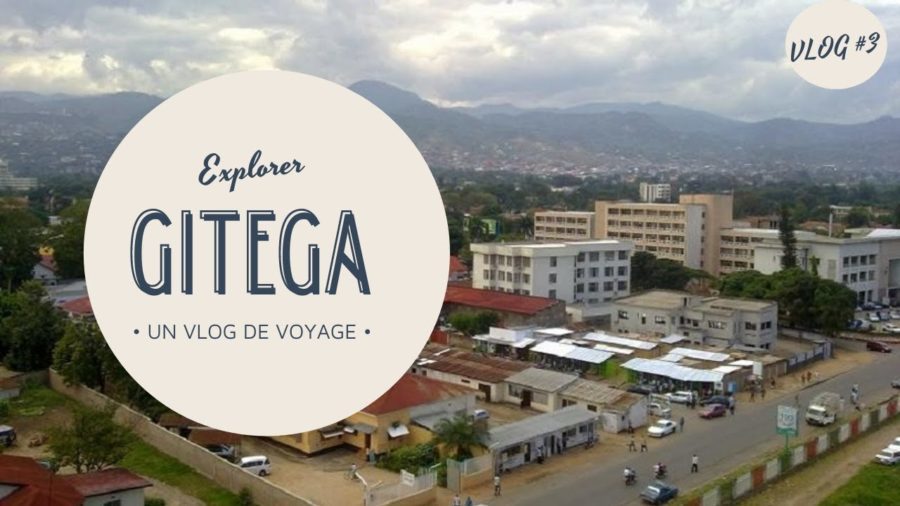
Finding Gitega
By Manu Gome
Known officially as Burundi’s 2nd city, Gitega sits high up in the hills, a two-hour drive east of Bujumbura.
My journey to this former colonial capital of Burundi started in the most ordinary way possible: I took a public minibus.
I like to use Public Service Vans (minibus) whenever possible because you are sure something interesting will happen on the way. This time was no different.
From the half-hour delay at Gare du Nord because, after over an hour of sitting in his van while it loaded passengers, the chauffeur realized only after it was full that he needed to change a tyre; to the comedic passenger who kept ‘threatening’ to get out of the van- for whatever flimsy reason came to his mind- but never did (even when the rest of us, fed up with his antics, begged him to go); to the fifth passenger in the first row of the van who, on seeing the police ran for the hills (literally) and left his luggage in the mini-bus, my journey was proving as entertaining as I had hoped. But there is another reason I like to use minivans: I feel they give an outsider a fairly good insight into the character of a country’s ordinary folk.
As we sped up the excellent tarmac road that winds through hills covered in banana plantations, cassava, climbing beans and tea, the easy chatter of the passengers amongst each other told of Burundians’ sociability; the man who shared his roasted peanuts with the rest of the passengers told of their generosity; the woman who, looking at a cloud-covered hill in the distance, nonchalantly remarked, “The hill is carrying clouds (on its head)”, told of the poetry of Kirundi; and the minivan’s conductor (locally called convoyeur) who begged and cajoled you sweetly to enter his car and turned into a fire-breathing Shylock as soon as you were firmly inside told me, well, that these guys are the same everywhere.
Finally, as the midday sun blazed right overhead, we arrived in Gitega. Many of the buildings have colonial architecture, giving the city a classic retro feel that makes you feel like a wanderer in some ancient city. Immediately upon entering the city center, you can see why Gitega is called the heart of Burundi. Apart from being geographically in the center of the country, Gitega is a throbbing, pulsating city, full of life and activity.
All around, traders and touts, beggars and taxi owners vie for your attention in alternating Swahili, Kirundi, and French as they struggle to place you. From afar each of the many shops seems busy, and you can see two or three customers standing and gesturing in the door of each one, while the busy shop owner, his body half-turned away from them, attempts to find their order on the shelves above.
After a couple of hours just walking the streets and popping into random shops in the baking sun, it was a relief to discover some great hotels- Tropitel, Helena, and Bethel to name just three- within or right at the edge of the city center where one could chill out. I had a delicious buffet at Helena Hotel and a relaxing afternoon with cold drinks at the luxurious Tropitel; and although I only spent one short afternoon in it, Gitega is certainly a place I will be returning to soon
Read MoreSisters of Rwanda
The Rwandan genocide of 1994 was a tragic period of history as most are aware, causing close to 1,000,000 deaths with over 99.9% of the population being witness to violence and death. Over 300,000 children were made orphans with over 85,000 under 18’s left with the responsibility of looking after their younger siblings. This has lead to many social problems with the younger generations today. Many girls were lead into prostitution due in large, to immense poverty and lack of knowledge of other alternatives.
This is a lonely life of abuse and neglect. Many are repetitively raped and it is believed that today in Rwanda around 25% of sex workers in Rwanda are HIV positive. Legally, Rwandan laws take a very strict criminalizing policy towards prostitution, with the sex seller rather than the sex buyer being prosecuted. When arrested the women are subjected to jail time with the children at most times being left at home to fend for themselves, and is too young left to die. Lots take to drug abuse as a way of coping with their circumstances leading to addiction and difficulty in taking proper care of their children.
Most are desperate to escape the industry but do not know how, feeling totally trapped. Sisters of Rwanda, is a new NGO attempting to break the cycle of prostitution in Rwanda, ending gender based violence and empowering women.
The start of Sisterhood
In the March of 2005 Pastor Joseph Ayienga began going out onto the streets, counseling women and giving them spiritual guidance, in an attempt to help them find a way off the streets. Although the women were unresponsive at first, lacking trust in men from years of abuse, in time they began to confide in Joseph, wanted to find out about the possibilities of leaving prostitution. Joseph did not like to call them ex-prostitutes so began to call them his sisters, leading to the name, ‘Sisters of Rwanda’. In May 2006 Jared Miller a long time humanitarian, met with Pastor Joseph and began to realise the possibilities to help these women escape from sexual abuse, aids and poverty. In December 2006 Sisters of Rwanda became a registered NGO and they haven’t looked back.
Programmes
Sisters of Rwanda now have a compound in the Gasbo District of Kigali where the women are able to come during the day with their children to take part in the programs offered. The NGO strongly believes in giving the women independence and are hoping to make the NGO financially self-sufficient by 2009.
(1) Income Generating Programme
Job opportunities are offered to the women, paying them a wage for pottery and embroidery. Through this, the sisters have a regular set income, hopefully decreasing the chance of them being forced back into prostitution. They are also in the midst of a deal with a big hotel chain, hoping to be given the rights to sell them regular supplies of soap and candles, enabling more sisters to enter the program.
(2) Education
The NGO has raised international sponsorship to enable some of the sisters children go to school. They are now paying the school fees for 34 children but are still in need for further sponsorship so as to be able to open this opportunity up for more. There are over 45 more children in need of education and it is also crucial that the funding continues to keep the current ones at school. They also offer after school English lessons to the children to aid them with their studies.
Future Development
There are also proposals in place to aid the women concerning their healthcare. Through research and interviews with the sisters, they realized the health problems countless face. In Rwanda most invest in a health policy. The Mutualle de Santé costs 1000 francs a year per person, which includes all health expenses. However many of the women, although having a policy, are not using it due to the consultation fee of around 200F, leading to illnesses.
Sisters of Rwanda wants ensure that all of the women and children are enrolled in Mutuelle, by creating a healthcare fund to subsidize the consultation fees and ensure that they are able to purchase medications, as at the moment many of the women are use traditional herbs when they are sick. They also want to put in place a comprehensive health education program to educate
women about reproductive health with a focus on preventative measures, and increase the women’s nutritional status through education and access to subsidized food. They would also like to offer the women education on their legal and human rights. Many are entitled to things such as child support but don’t know how to go about claiming it. When talking to the women they also discovered an interest in programs such as will writing, something of particular importance to the HIV suffers.
On a larger scale the NGO is also conducting advocacy to impact legal legislation for punishing prostitution in Rwanda. They would like to see the focus shift to criminalizing the buying rather than the selling of sex, placing the burden of punishment on the clients who perpetuate the sex trade, rather than the women who are trapped in the business. Moreover, they would like to see greater emphasis on programs to help sex workers leave the trade. A similar legislation was enacted in Sweden, with the government aiding programs similar to Sisters of Rwanda to give women other
options. As a result, the number of prostitutes dropped by two thirds and 80% of men discontinued buying sex. This truly highlights the enormous positive effect this change in law can make in decreasing the destructive pattern of sex selling.
How you can get involved: To find out more go to www.sistersofrwanda.org
Read More
Rwanda Women’s Network
As a result of the 1994 genocide, Rwanda was left with a large number of widows and orphans; many of whom had suffered the worst inhumanities ranging from rape to torture. For these survivors, their social and psychological scars were coupled with having no financial support in their new roles as heads of households, often caring for a number of orphans in addition to their own children. With limited or no technical skills, education, or access to financial resources, despair and depression became dominant forces in their lives. Coupled with this was the culture of silence and stigma directed towards these vulnerable groups.
Rwanda Women Network (RWN) is an NGO that has worked in Rwanda since 1997 to directly address the situation described above. RWN was established with the mission to work towards the promotion and improvement of the socio-economic welfare of women in Rwanda through enhancing their efforts to meet their basic needs.
The organization’s objectives include:
To economically empower poor women and widows in the rural and urban areas;
To foster economic and social growth within households and communities;
To improve the health status of widows and orphans;
To promote peace and reconciliation.
Rwanda Women Network implements four core programs:
Health-Care
The RWN health-care program is implemented through the Polyclinic of Hope (PoH), located in Nyamirambo, and its three replications; The Village of Hope, in Kagugu, PoH Bugesera, and PoH Huye. Adopting a holistic approach to cater to women survivors of the genocide, and their families, the program empowers them through varied projects on sexual and reproductive health, sexual and gender-based sexual violence, primary health care, shelter construction and rehabilitation, HIV/AIDS prevention, care, and support.
Education and Raising Awareness
Education and Awareness-raising is an all-encompassing activity that includes education on legal and human rights, HIV/AIDS, sexual and gender-based violence, and reproductive health. RWN’s success in this area are many, women who received training in legal and human rights issues have been empowered to actively take part in the community court, Gacaca, some even acting as judges. Many partners have taken on the responsibility of caring for those affected and infected with HIV/AIDS in their communities. RWN facilitates training in areas such as palliative care and OVC support which enable these groups to effectively help their fellow neighbors.
Socio-Economic Empowerment
RWN recognizes that women if they are to sustainably meet their specific basic needs, must be economically empowered. RWN enables women to obtain a sense of security and a hopeful future by facilitating access to financial credit, for the development of income-generating activities. Basket weaving, agriculture, tailoring, shoemaking, and small kiosks are just a few examples of the income-generating activities undertaken by women.
Networking and Advocacy
Networking and advocacy are essential in broadening the reach and effectiveness of RWN’s programs, as well as promoting community dialogue with local authorities and policymakers. RWN works with its community partners to promote linkages between them and other key organizations/institutions at the national, regional, and international levels. Through these linkages, RWN and its partners gain learning opportunities, networking, solidarity building, and the establishment of working relationships.
RWN, with its various achievements through its community-based programs, has gained wide recognition as a model in community development that can be replicated globally.
For more information contact us at
+250 -583662, rwawnet@rwanda1.com or visit our website www.rwandawomennetwork.org
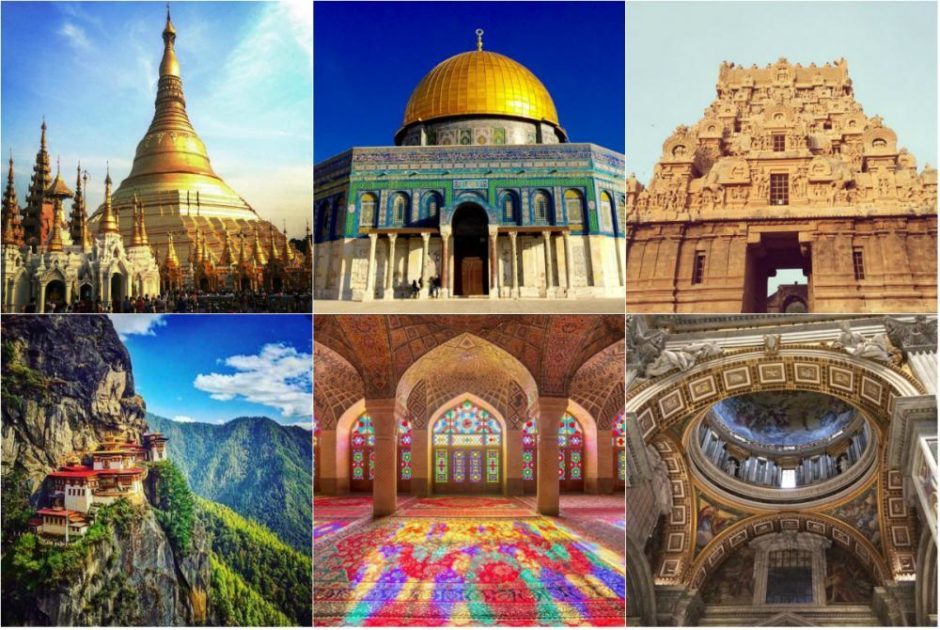
Places of Worship
Africa Gospel Church/World Gospel Mission – Kigugu,
Kampala. Tel: (041) 266568, (041) 510292.
All Saints – Akii Bua Road, Nakasero. Tel: (041) 342128.
Baha’i House of Worship – Kikaya, Kampala.
Tel: (041) 540511.
Baptist Mission – 42 Bombo Road. Tel: (041) 541497.
Christ the King Catholic Church – Colville Street, Kampala. Tel: (041) 241505.
First Presbyterian Church in Rwanda – Kisenyi Road,
Kampala. Tel: (041) 273128.
Hindu Temple – 8/10 Snay Bin Amir Street.
Tel: (041) 256036.
Kampala Baptist – 909 Hoima Road. Tel: (041) 530899.
Return to top
Kampala International Church – Heritage International School, Kansanga, off Ggaba Road.
KPC – 87 Kampala Road, Tel: (041) 345125.
Kibuli Mosque – Kibuli Hill, Kampala.
Makerere Community Church – Makerere University
Faculty of Veterinary Medicine. Tel: 0772 641028.?
Makerere Full Gospel – Sir Apollo Kaggwa Road.
Tel: (041) 540437.
Orthodox Church – Hoima Road. Tel:(041) 542461.
Rubaga Cathedral – Rubaga Road. Tel: (041) 258112
SDA – Makarere Hill Road. Tel: (041) 542455.
St Paul’s Namirembe Cathedral – (Anglican),
Namirembe Hill. Tel: (041) 270212.
Uganda Martyrs Shrine – Namugongo. Tel: (041) 285504.
Universal Church of the Kingdom of God – Plot 8-12 George Street, Kampala. 0772 439127
Verona Fathers – 17 Boaz Mau Road, Mbuya.
Tel: (041) 221001/2.
